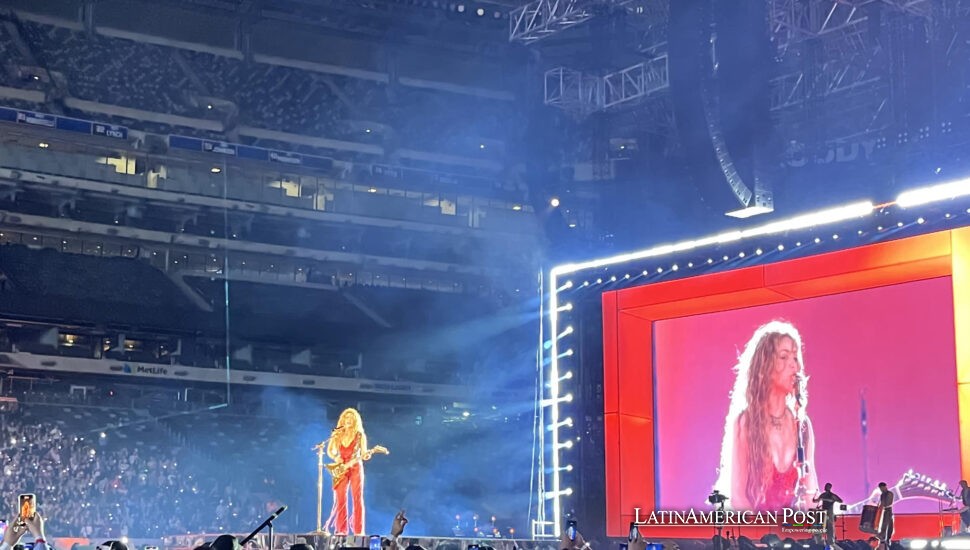Fans Roar as Colombian Songstress Shakira Revisits Her Immigrant Tale

Shakira ignited the stage in New Jersey as she honored her immigrant past, celebrating the journey that began when she moved to the United States at nineteen. She showcased her resilience and global success with stirring anthems and bold visuals.
Remembering a Nineteen-Year-Old Dreamer
Not long ago, Shakira took the spotlight at New Jersey’s sprawling stadium on her “Las mujeres ya no lloran” tour, and it was here that she reminisced about her arrival in America as a wide-eyed teen from Colombia. She recalled the day she stepped onto U.S. soil, filled with nervous energy and high hopes for whatever might lie ahead. No one, not even she, could have predicted that her voice would soon become a guiding light for a new wave of Latin talent, encouraging them to dream just as boldly.
An unexpected train strike delayed the concert, leaving fans restless, but Shakira turned that collective frustration into a decisive moment of unity. She asked people to recall their past experiences, including difficulties, small successes, and motivations. Her story appeared similar to each person’s. It showed an encouraging mix of cultures and problems, all leading to the skill that developed her memorable show.
From “Objection (Tango)” to Modern Reggaeton Beats
Once the stage lights came alive, Shakira wasted no time taking the crowd on a tour of her musical evolution. She introduced “Objection (Tango)” by describing it as the work of a young newcomer to English who wanted to blend a Latin heartbeat into mainstream pop-rock. That sense of early determination came through loud and clear, reminding everyone of the cultural hurdles she once had to leap.
But then, as if flipping a switch, she moved into tracks with a reggaeton spin—like “Te Felicito” and “TQG.” The pace revved up, and it was impossible not to notice the unstoppable energy radiating from the stage. Giant screens flashed flags of different Latin American countries, a colorful representation of the many communities who have championed her over the years. The tribute showed Shakira built her legacy through collaboration. Inclusion played a part. She did not limit herself to only one genre.
Embracing Vulnerabilities and Empowering Women
Between each wave of music, Shakira found a few moments to open up about recent personal setbacks she’s weathered. She spoke of raising children independently and of women worldwide who start over, whether by choice or necessity. Instead of lingering on painful details, she emphasized how crucial self-love is—particularly when a relationship loses sight of one’s worth.
Her emphasis on renewal and strength was symbolized through a virtual image of a fierce wolf shifting into a maternal guardian. The screens showed the wolf caring for her young. After that came clear pictures of Shakira’s children, Milan and Sasha. At the same time, the gentle music of “Acróstico” played inside the stadium. In that short emotional instance, the pop star displayed her two jobs. She is a performer, and she is a parent. Each job has continuous dedication.
Transformations and Surprises: A Full-On Spectacle
Shakira altered her stage persona every few minutes in ways that kept the audience on their toes. She might strut with a pole in a sultry dance routine, only to sling on a guitar moments later, unraveling some of her rock-infused roots. Nostalgia surged as she revisited the barefoot days of “Pies Descalzos,” reminding the crowd of the free-spirited artist she’s always been.
Ozuna appeared on the stage, increasing audience excitement. Her appearance indicated that Shakira can form musical relationships across musical styles. On the tour, she performed with Alejandro Sanz and Wyclef Jean, showing that her method includes others. While fans roared for the collaborations, Shakira’s real star power remained, as her voice and fiery charisma poured unity into every song and routine.
Howling Finale and Triumph in Every Note
Saving the most potent punch for last, Shakira belted out “Bzrp Music Sessions, Vol. 53,” a track brimming with unapologetic lyrics aimed squarely at a past partner. The phrase “a she-wolf like me isn’t for guys like you” cut through the air, turning the stadium’s collective shout into an anthem of self-assertion. The next song, “She Wolf” (or “Loba”), roared to life beneath a dramatic wolf sculpture beaming lasers, though the star’s fierce gaze was all the crowd needed to see.
In those final moments, she unleashed a blizzard of faux currency, each bill stamped with her image—an audacious nod to her now-famous motto: “Las mujeres ya no lloran, las mujeres facturan.” Fans scrambled to catch these airborne keepsakes that symbolized hard-earned empowerment. For Shakira, tossing them into the cheering audience was a way to honor all she’d overcome—coming to the States with almost nothing in her pocket, trusting her talent and grit to see her through.
As the last notes rang out, it became crystal clear that her life story wasn’t just about climbing the charts. It involved continued effort, honest conduct, and the creation of possibilities for subsequent individuals. The audience clapped as she departed. The event gave a shared recognition. Her start as an immigrant, her commitment to imaginative expression, and her support for the advancement of women are all greater than any platform she occupies.
Also Read: Venezuelan Journeys, Ecuador Dreams Thrive Under Pope Leo’s Migrant Promise
The evening wrapped up in a flurry of emotion, cultural pride, and fearless self-expression—an unmistakable testament to her Colombian heritage and the immigrant path that shaped her artistry. Each note she sang that night reminded everyone in attendance that the dreams you nurture can, in fact, grow into something magnificent once the world hears your voice.





